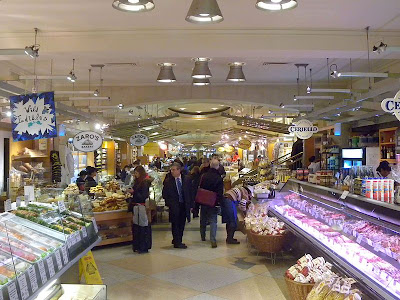Manhattan's Grand Central Station Celebrates Its 100th Anniversary |
| Grand Central Station New York City, New York |
Grand Central Station, one of the landmark buildings of New York City, is a century old this year. More than 700.000 people pass through it each day with little or no thought of its history or importance, but it played a significant role in the city’s growth and expansion. Railroads were a principle mode of transportation in the 19th Century and the early decades of the 20th moving both people and commerce enabling the growth of the city and nation.
New York’s first rail service was begun in 1831 and during the 1840s several additional lines were begun adding a variety of terminals, depots, freight houses, and passenger stations throughout the city. A haphazard network of railways resulted in noise, pollution, traffic, and chronic accidents. By 1858, steam locomotives were banned from much of the area and were no longer in service below 42nd Street. A new terminal was needed. In 1869, shipping magnate "Commodore" Cornelius Vanderbilt purchased property between 42nd and 48th Streets, Lexington and Madison Avenue for construction of a new rail yard and the first Grand Central. It cost $6.4 million and opened in October 1871 serving three different railroad companies. However, it was nearly obsolete from the beginning and had to be substantially enlarged in 1898. The updated station featured a classical facade, a unified 16,000 square foot waiting room, and distinctive ornamentation including monumental cast-iron eagles with 13 foot wingspan. Perhaps most significant was its 650 foot long train shed.
The age of steam locomotives (in the city) was quickly drawing to a closed and following a catastrophic accident in 1902 that killed 17 and injured 38 there was a public outcry for electric powered trains. Within months plans were made to demolish the existing Grand Central Station and create a new double level terminal for electric trains. This was an expensive project ($80 million or roughly $2 billion today). It took ten years to complete and drastically changed the cityscape forever. The former rail yards were paved over from 45th to 49th streets and developers paid the New York Central Railroad for “air rights” to build on top of the new tracks. And build they did, including dozens of large apartment buildings, hotels, and corporate headquarters along Park Avenue and adjoining streets. The new Grand Central Terminal opened in 1913. More than 150,000 people came to see it on the first day.
Fast forward five decades to 1967 when the building was threatened with demolition (it had already happened to the city’s other railroad terminal Penn Station). A group of city leaders were successful in preserving the building an having it designated a national historic landmark in 1976. Two years later it won a case before the U.S. Supreme Court sparing it from the wrecking ball.
After decades of deferred maintenance, the building was crumbling. The roof leaked, stonework was chipping away, structural steel was rusted, pollution and dirt had stained surfaces, and commercial signs blocked out natural light In 1883, Metro-North took over operation of Grand Central Terminal, and soon after the railroad began a systematic program of repairs and capital improvements, including a $4.5 million project to replace the leaking roof and skylights. However, people soon realized that what was needed was a new terminal building. In 1884, architects began working on plans and six years later construction started.
Excavation was a huge job since the rail yard had to be lowered an average of 30 feet below street level. In spite of the construction project, rail service continued uninterrupted. Trains continued to use the old Grand Central, until it was razed in 1910. A temporary station at Lexington and 43rd Street was used until 1912.
Forty years later, faced with declining income and rising costs, in 1954 the owners resolved to make the most of its assets, commissioning plans to demolish Grand Central Terminal and replace it with a 6 million square foot office tower. Nothing came of this plan, but in 1958 it agreed to demolish the six-story office structure at the rear of the terminal and replace it with the 59-story Pan Am Building which opened in 1963.
Fast forward thirty more years. In 1994, the Metropolitan Transportation Authority gained long-term control of Grand Central Terminal in the form of a 110-year lease from American Premier Underwriters, a successor to the Penn Central Corporation. A comprehensive revitalization plan was begun in 1996 with the cleaning of the main concourse Sky Ceiling. As restoration and renovation continued, the project generated more than 2,000 construction and construction related jobs. The revitalization project culminated with a gala rededication celebration in 1998.
Now, completely restored back to it's 1913 splendor, Grand Central has become a midtown destination with five exquisite restaurants and cocktail lounges, 35 casual international eateries in the lower level Dining Concourse, gourmet foods from the Grand Central Market, and 68 unique specialty shops throughout the concourses. All this in addition to the trains.
Happy Birthday Grand Central.
Grand Central has become an international example of a successful urban project that gave new life to an historic building which otherwise would have been discarded and destroyed.
 |
| Grand Central Station Main Concourse |
 |
| Grand Central Food Market |
 |
| Grand Central Oyster Bar |


No comments:
Post a Comment